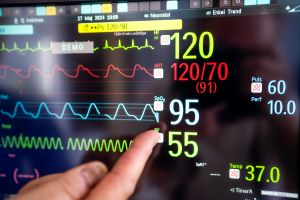Collaboration Project Develops Early Warning System to Reduce Infant Mortality
Region Stockholm

A pioneering collaboration between healthcare professionals and data engineers could bring about a significant change in patient monitoring and help reduce the rate of infant mortality.
Five percent of newborns are born prematurely. Add those that encounter complications during pregnancy and birth and the result is a large number of babies often requiring intensive care. The majority of them suffer some kind of failure in their own functions and many children die every year.
This realization formed the genesis of a collaborative project between Region Stockholm, KI and KTH that combines clinical expertise with advanced data processing and presentation communication technology. The project received funding from Region Stockholm and KTH´s joint call health and medical technology (HMT).
Detection of early signs
The problem facing hospitals today is that although huge amounts of data are generated with modern measurement and monitoring equipment, there isn’t the capacity available to fully process it.

“In hospitals, patients suddenly get very sick, unexpectedly,” says KI Professor Eric Herlenius. “We take a biomarker, and you have to take a test, run to the lab, examine it and go back to that analysis. That takes time, and the patient may be dead by the time you get the answer.”
However, before this stage there are often signs that the patient is in danger. If these signals can be detected sooner, it could make a major difference to their outcomes, according to Herlenius. “Initially, you have subtle symptoms of physiological parameters, called physio markers – dynamic changes of heart rate, respiration, saturation. But to be able to analyze this, you have to have really good data management,” he says.
A team was put together, led by KI Professor Eric Herlenius with crucial collaboration and assistance by Associate Professor Saikat Chatterjee (KTH) and Mikael Skoglund (KTH) as assistant supervisors, and PhD student Antoine Honoré (KTH). Their challenge was to design, test and deploy a hospital-wide solution capable of real-time data analysis.
The group developed a new deep machine learning-based early warning system that uses data already available from patient monitors. Data that had previously been thrown away after one week on the server. “We developed a system where we can harvest and store the data long term, which allows for comprehensive analysis and better predictive capabilities,” says Chatterjee.
AI and machine learning in patient care
The early results of the collaboration are encouraging, according to the team. Monitoring the heart rate characteristics of premature babies alone could help reduce mortality in the intensive care unit by some 20%. By using dynamic signals and machine learning, they are now able to detect patient deterioration more than 24 hours before traditional methods.

However, their ambition for the project goes farther. “Our goal is to extend this window to 72 hours, or as early as possible,” says Herlenius.
This pioneering collaboration between doctors and engineers has already succeeded in paving the way for a future where advanced data management and machine learning could become integral to patient care. Their ultimate aim is to achieve real-time precision medicine by continuously monitoring patients and analyzing data that can help doctors make potentially life-saving interventions.
In terms of the future, the next challenge is funding. While their research has shown highly promising results, the team acknowledges that large-scale implementation in hospitals would require significant investment.
“By investing this money, though, you’ll save lives every day and improve healthcare,” says Herlenius. “We’re still in the research phase, but the potential to revolutionize medicine is clear.”
Text: Annelie Englund
Photo: Magnus Glans
You have previously denied the display of content of the type "External media". Do you want to show content?
